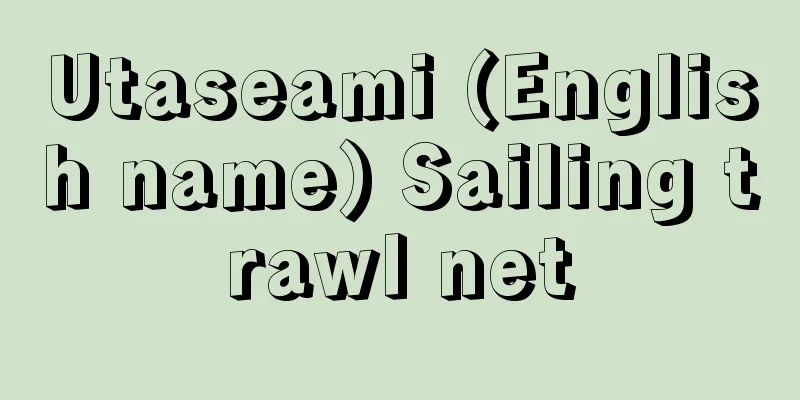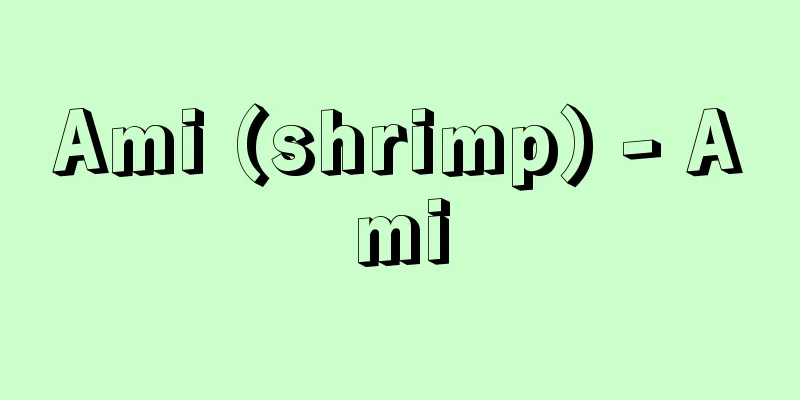Utaseami (English name) Sailing trawl net

|
Among fishing nets, this is a type of seine net, belonging to small motorized bottom trawl fishing. It is a fishing method in which a sail is set on the boat, or a tidal sail is set in the sea, and the boat is moved sideways by wind or tides (moving in a direction almost perpendicular to the line connecting the bow and stern), or a bottom trawl is towed. The former is called sail-attack net (also called wind-attack net, famous for the smelt fishing in Lake Kasumigaura, which is often seen in photographs as a seasonal feature), and the latter is called tide-attack net. There is also oar-attack net (row-attack net), which is rowed by hand. The fishing grounds are lakes, marshes, and inland bays, and bottom trawl nets are pulled on flat areas with sandy and muddy bottoms. The operation is carried out by extending poles from the bow and stern of the boat, and attaching tow ropes, sleeve nets, and bag nets to the ends of the poles. The fishery targets weak swimming fish such as smelt, shrimp, flatfish, filefish, and squid. Some fishing gear does not have a net mouth opening device, has a beam at the net mouth, or has a girder at the net mouth. This type of fishing usually uses power to travel to and from the fishing grounds, but since no power is used for operation, productivity is low. For this reason, many fishermen are gradually switching to powered hand-pulling nets, and this fishing method is declining. [Hideo Soeda] [Reference items] | | | | tide | | |Source: Shogakukan Encyclopedia Nipponica About Encyclopedia Nipponica Information | Legend |
|
漁業の網漁具のうち、引網類の一種で、小型機船底引網漁業に属する。船上に帆を張り、または海中に潮帆(しおほ)を張って風力または潮流によって船を横に移動させたり(船首と船尾を結ぶ線とほぼ直角の方向への移動)、底引網を引航して行う漁法である。前者は帆打瀬網(風打瀬網ともいい、季節的な風物詩として写真などでよく目にする霞ヶ浦(かすみがうら)のワカサギ漁などが有名)とよばれ、後者は潮打瀬網とよばれる。そのほかに人力で櫓(ろ)を漕ぐ櫓打瀬網(漕ぎ打瀬網)などがある。漁場は湖沼や内湾で、底質が砂泥で平坦な場所を引く底引網である。船首と船尾に張り出し竿(ざお)を張り出し、その先端に引綱、袖(そで)網、袋網を取り付けて引網する方法で操業を行う。漁獲対象は、遊泳力の弱いワカサギ、エビ類、カレイ類、カワハギ、イカなどである。網口開口装置を有しないもの、網口にビーム(梁(はり))を有するもの、網口に桁(けた)を有する桁網などの漁具を使用するものもある。この漁業は通常、漁場の往復には動力を用いるが、操業には動力を用いないので生産性が低い。そのため徐々に動力を用いる手繰(てぐり)網に転換する漁業者が多く、漁法としては衰退している。 [添田秀男] [参照項目] | | | | | | |出典 小学館 日本大百科全書(ニッポニカ)日本大百科全書(ニッポニカ)について 情報 | 凡例 |
<<: Song of the Sutra - Utasekkyo
Recommend
Ludwig van Beethovens Leben
…He served as a member of the American embassy in...
intime conviction
…It is a legal term for the evaluation of evidenc...
Isawa [town] - Isawa
An old town in Higashiyatsushiro District, Yamanas...
Transformational body - Henkeitai
The term refers to the multinucleated trophic bod...
Lizardite
...The name comes from its snakeskin-like appeara...
People's Daily - Jinmin Nippon
The official newspaper of the Central Committee o...
Yunono [Hot spring] - Yunono
This hot spring is located in Kirishima-cho, Aira-...
Silver acacia
→ Acacia Source: Shogakukan Encyclopedia Nipponic...
Paragraphia
…Intralingual disorders inevitably lead to simila...
Hotspot - Hotspot (English)
A location where energy or the occurrence of an ev...
Kaluza, TFE (English name) KaluzaTFE
...In other words, although mathematically comple...
Theocentrism - kamichuushinshugisiso
…All of this was the natural outcome of the work ...
Motoyoshi - Kiko
…After Seishin's death, he studied esoteric B...
Winter Mountain Temple
This temple is located in Suzhou, Jiangsu Provinc...
Sessai Masuyama - Sessai Masuyama
Born in 1754 in Ise [Died] 29 January 1819. A pain...









